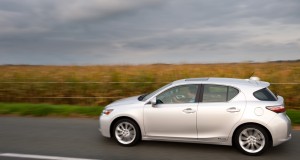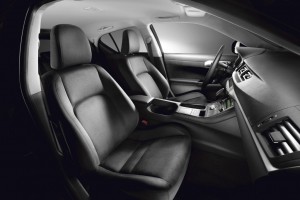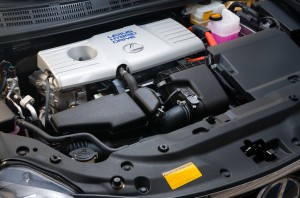It would be easy to write off the Lexus CT200h is just a gussied up version of Toyota’s hybrid poster child, the Prius.
It’s true that the CT 200h shares its platform and most of its hybrid mechanicals with the Prius, but where the Prius is a snooze to drive, the Lexus is fun. Can an underpowered hybrid that’s geared for mileage, not performance, be fun? In a word, yes.
If you need eye-popping acceleration, look elsewhere. In fact, if you expect average acceleration, look elsewhere. With a combined 134 horsepower between its 98-horsepower 1.8-liter four cylinder and 80-horsepower electric motor, the CT isn’t going to win any stoplight grand prix. Well, unless, the competition is a Prius.
But the CT is one of those cars that make spouses complain “What, do you think you’re Mario Andretti?” The hefty steering begs for you to take corners a little faster than normal, clipping apexes with the precision of a sports car. So there’s a Prius lurking under the CT’s sheetmetal? No one will ever know.
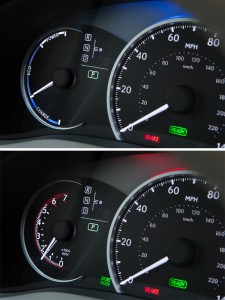
The CT 200h's gauges change in Sport mode, below. The power gauge becomes a tachometer and the gauges glow red instead of blow.
The ruby red test car, which was actually a preproduction model, was a great perch for a 500-mile roundtrip business excursion for three. There was plenty of room for bags, laptop computers, cameras and other paraphernalia. Three guys plus stuff seemed to do little to affect the CT’s acceleration or ability to keep up with traffic.
The front seats are somewhat tight, in that sports car sort of way. The deeply bolstered buckets are a perfect place to do business in a car that wants to be flung through corners. The steering weights up nicely off center and offers a good sense of on-center feel. It’s not very quick, but it offers good feedback about what’s going on with the tires.
Rear-seat passengers have decent room, except for kneeroom which is a little tight if the passenger in front of that seat insists on leg-stretching space. Surprisingly, there are no cupholders accessible to rear-seat passengers. The 60/40 rear seat folds to expand cargo space, but there is no center armrest and no pass through for longer items like skis.
There are four drive modes: Normal, Sport, Eco and EV, controlled by a button and big knob in the middle of the center console. The difference in performance between Sport, Eco and Normal seems negligible. Turn it to Sport and the Eco gauge on the center console becomes a tachometer and the instrument panel glows red instead of blue. The accent lighting inside the car turns from blue to red as well.
EV mode allows the car to accelerate – very slowly – up to a maximum speed of 28 mph before the gas engine kicks in. In reality, EV mode is pretty much useless. If the car can shut off its engine, it will, making the EV button irrelevant. It can maintain about 45 mph without the engine for brief periods, which means the engine shuts down when approaching traffic lights.
Lexus rates the CT at 43 mpg city and 40 highway. We saw 37 in mostly freeway and highway driving, always the weaknesses for hybrids. The Prius has a combined rating of 50 mpg.
Of course, not all is perfect in the CT. While most hybrids make use of continuously variable transmissions, the typical engine droning is annoying in a luxury car. How about giving the Sport mode a shift program that replicates a conventional transmission’s shifts, similar to the system in a Dodge Caliber? Yes it would hurt fuel economy, but don’t the CT’s chunky 215/45 17-inch tires hurt fuel economy as well?
Speaking of the engine, it sounds rather crude for a Lexus. That the small four cylinder isn’t better isolated is shocking for Toyota’s luxury brand. It doesn’t make pleasant sounds, either.
Styling is what one might expect for this cheapest Lexus. The basic shape is reminiscent of a Mazda 3 hatchback, but typical styling cues make it obviously a Lexus.
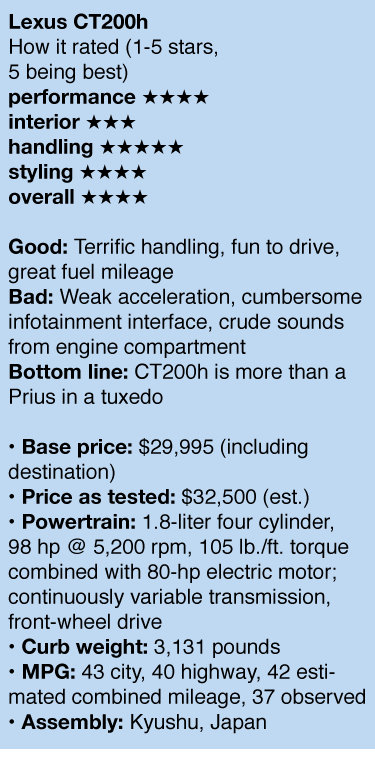 While the interior is very comfortable, the interface for the navigation/infotainment system is cumbersome. There’s a joystick-style mouse to navigate the various systems. While these type of systems have become popular, it seems to present a safety hazard while driving. Too much time with your eyes on the screen and not on the road. In the test car, some functions – such as radio presets – are only available through the menu-driven system, a lazy mistake.
While the interior is very comfortable, the interface for the navigation/infotainment system is cumbersome. There’s a joystick-style mouse to navigate the various systems. While these type of systems have become popular, it seems to present a safety hazard while driving. Too much time with your eyes on the screen and not on the road. In the test car, some functions – such as radio presets – are only available through the menu-driven system, a lazy mistake.
Lexus offers a service similar to OnStar that allows users to get directions sent to their car or find businesses. Like OnStar, it can also auto report crash information. But unlike OnStar, there’s no readily accessible button. Accessing it requires using the menu system or voice control via a steering wheel-mounted button.
The CT will start at $29,995. With a few optional extras, the test car should sticker at a little more than $32,000.
A few CT200h oddities: The car beeps like a garbage truck when in reverse. Fortunately, it’s not audible outside of the car. The info display tells you to turn off the lights, even though it has automatic lights that turn off on their own. Could these be bugs that Lexus will fix before production cars hit street? Probably.
In many ways, the CT is the future of luxury transportation. Cars are getting smaller, fuel economy is going up. While many drivers want the performance offered by some Lexus models, others couldn’t care less.
Even without blistering acceleration, the CT is fun to drive. It willingly attacks corners with the friskiness of a kitten.
The tradeoff is something anyone can appreciate – less-frequent, less-expensive visits to the gas station.

